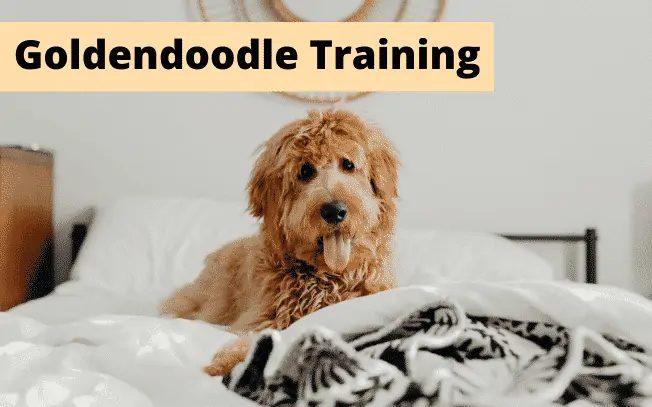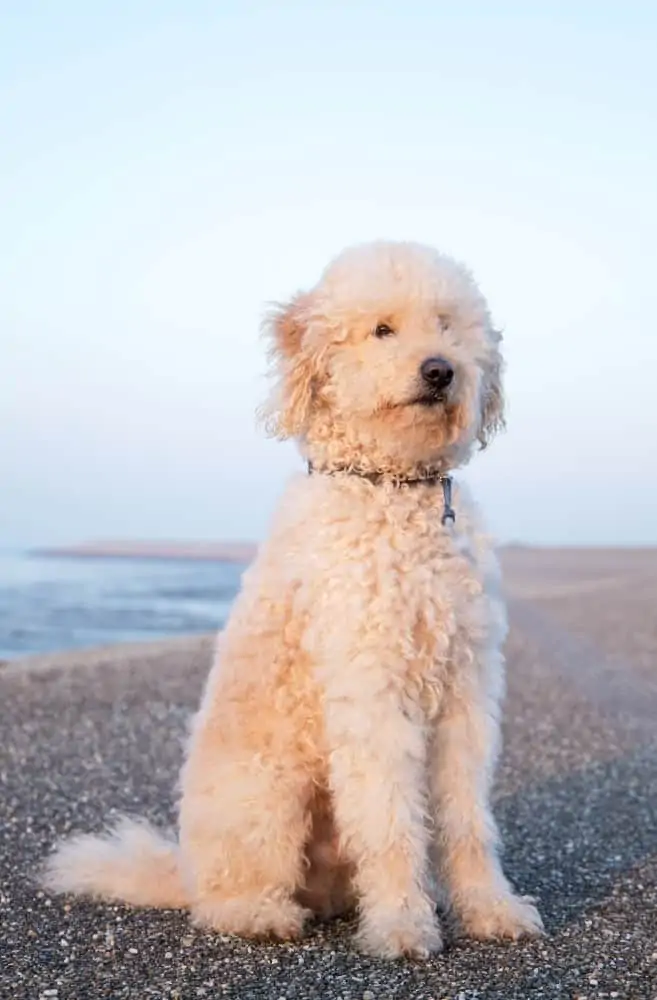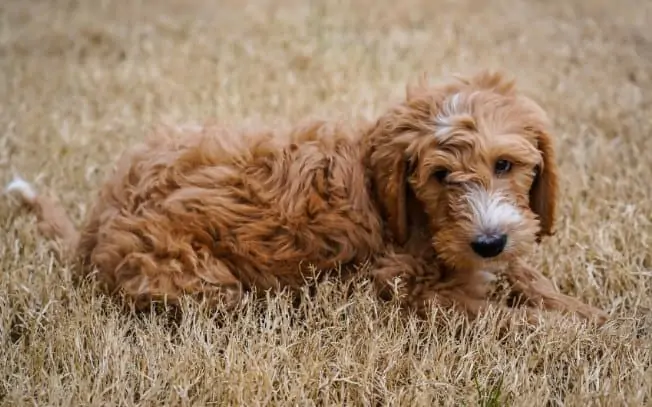Last Updated on

Getting a new Goldendoodle puppy is an exciting time—after all, you will have a hard time finding a cuter companion!
However, getting a Goldendoodle (or Mini Goldendoodle) puppy also comes with a big responsibility—training your Goldendoodle puppy. And puppy behavior, while it may seem cute at first, loses its appeal when you suddenly have an adult dog with behavior issues.
Puppies can act like little sponges, learning new things all the time. It’s important to set your Goldendoodle puppy up for success by training them right from the start, so they learn what you want them to learn instead of bad habits.
In this article, we will cover the basics of training a Goldendoodle puppy, the most important things to teach your Goldendoodle, and how to make sure your pup is comfortable in their crate.
After reading, you’ll have the skills you need to get your Goldendoodle pup off to a great start with training!
Understanding Obedience Training Methods
Goldendoodles learn best with positive reinforcement obedience training methods, especially when they are young puppies.
The basics of teaching with positive reinforcement include:
- Teaching your dog what you want them to do, rather than what you don’t want them to do.
- Rewarding good behavior with a reinforcement your dog likes, such as a treat, a toy, or a walk.
- Setting your puppy up for success by changing the environment or the situation so they can be more likely to make the correct choice.

It’s important to understand that “positive reinforcement training” isn’t a monolith. While it’s often called a training method, there are actually a variety of methods that can utilize positive reinforcement training strategies to tackle training a problem behavior.
If one particular training strategy isn’t working, it’s OK to switch to another—but your goal when training your Goldendoodle should be to train them in the kindest and most effective way possible.
LIMA and the Humane Hierarchy Dog Training Methods
One way to think about that strategy is via the LIMA, or Least Intrusive, Minimally Aversive, framework.
LIMA training goes hand in hand with another concept called the Humane Hierarchy.
Under the Humane Hierarchy, trainers should choose to solve behavior problems in the following manner:
- First, evaluate the dog’s wellness.
- Are their health, physical, or nutritional factors that could be addressed first to change a dog’s behavior?
- Next, evaluate the antecedent arrangements.
- This step refers to addressing if you could change a dog’s environment in order to change their behavior.
- If you can’t cause change with the first or second options, trainers should next use positive reinforcement methods to try and change a dog’s behavior.
- Positive reinforcement methods involve rewarding the dog for the behavior you want to see more of in the future.
- Option four is the differential reinforcement of alternative behaviors.
- In this step, you would work to train an alternative behavior as a replacement for the problem behavior, while removing whatever was making the problem behavior rewarding.
What I love about the Humane Hierarchy is that it forces us to look at training from the dog’s perspective, and work to find a solution that is the least intrusive, minimally aversive for the dog.
We often think about dog training from the human perspective—what we need as dog owners—rather than from the dog’s perspective.
Not only will your training be more kind and fair when you consider things from your Goldendoodle’s perspective, but your training will also be more efficient and effective!
Clicker Training
Clicker training, or using a marker to let the dog know when they’ve done something earning them a reward, is one effective way to train your Goldendoodle with positive reinforcement.
In clicker training, the marker that is often used is a small metal and plastic object called a clicker. It produces a sharp “click” sound when a button is pushed.

You can also utilize other markers, though.
Owners of deaf dogs have used the blink of a flashlight or a thumb’s up sign, and dolphins are often trained with a whistle as their marker. Even your voice can work, such as saying “yes!”
The first step to clicker training is to teach your Goldendoodle that they will earn a reward whenever they hear the click.
This is called “charging the clicker” and is done by taking 10 treats, and then doing:
- Click
- Brief pause
- Give a treat
For all 10 treats. At the end, you should start to see your Goldendoodle look for a treat when they hear the click!
Once you’ve completed this step, you’ll be able to use your clicker to teach all sorts of new behaviors by clicking the moment your dog does something right.
For example, if teaching your Goldendoodle to sit, you’ll click the clicker the moment your Goldendoodle’s rear end touches the ground. Then, you’ll follow it up with a treat reward.
Top 4 Basic Commands to Teach in
Goldendoodle Training

There are 4 basic commands that I think are the most important to teach your Goldendoodle puppy from a young age. If your Goldendoodle can perform these 4 behaviors, you’ll be able to take your puppy more places without stress.
Hand Target
The number one thing that I teach every dog I work with is a hand target. When your dog performs a hand target, they’ll be touching their nose to your open palm.
This allows you to do a wide variety of things, including:
- Get your Goldendoodle’s attention focused back on you
- Move your Goldendoodle on or off of furniture
- Have your Goldendoodle walk at your side, touching your hand, if they are tall enough
- Call your Goldendoodle back to you and directly to your hand
The steps to teaching a hand target with a clicker are:
- Present your open palm hand to your dog, just a couple inches from their nose.
- If they reach their nose to sniff your hand, click and treat!
- Continue presenting the open palm hand close to your dog and clicking and treating for reaches.
- Next, try and wait for your dog to get even closer to your hand and touch it before clicking.
- The criteria at this step is “nose to hand.”
- Some dogs skip straight to step 2. If your dog is struggling, place a treat in between your fingers in your open faced palm several times to start the behavior.
- Click and treat when your dog’s nose touches your hand, and then after 3 repetitions with treats in your hand, begin repetitions without.
- At this step, your dog should be reliably touching their nose to your hand when you present your hand. We will now add a verbal cue.
- Say “touch” or “target” or “hand” (or other cue) right before you present your hand to your dog. Continue to click and treat for nose to palm.
- When the dog understands the former steps, we will begin to put the target in different places. Try holding the target a little higher, lower, different sides of your body, etc. Practice until it doesn’t matter where your hand is.
Emergency Recall
When you teach your Goldendoodle an emergency recall, you should be teaching them to race back to you immediately and as quickly as possible when they hear the cue. Your emergency recall should be something you don’t casually say – so stay away from “come” and “here” in most cases.
Instead, consider a specific word or phrase you wouldn’t use otherwise. I call my dogs with a “pup-pup-puppy!” and a whistle can also work.
Teach the emergency recall by teaching your dog the cue is an invitation for the best party in the whole world, right at your feet.
Feed delicious treats, cheer for your dog, play short games of chase (with your Goldendoodle chasing you!), and reward with a game of fetch or tug until your Goldendoodle can’t help but race back to you when you give your emergency recall cue.
The emergency recall is not only important if you plan to hike off-leash with your Goldendoodle, or pursue any off-leash training, but also as a safety measure should a leash break or a door be left open on accident.
Knowing your Goldendoodle will come back when you call them is critical for feeling safe when taking your Goldendoodle on new adventures.
Sit or Down
Notice this “must know” is actually one of two options – sit or down. Your Goldendoodle truly doesn’t need to know both, unless you plan to compete in obedience, rally, or another event requiring both behaviors.
Instead, you just need a way to ask your Goldendoodle to wait in one position. Sit or down is often easier to teach than a stand, since dogs are less likely to move when sitting or laying down.
You can start to teach your Goldendoodle to sit or down by luring them into the position with a treat. Mark and reward your Goldendoodle when they perform the correct behavior, and then work on fading out treats so they remain in your pocket until after your Goldendoodle does what you’ve asked.
Leaving treats in your hand too long can result in bribing your Goldendoodle, and it will be more difficult to get them to do the behavior without treats in the future.
Ideally, you should practice a sit or down with your Goldendoodle until they can also stay in that position, and sit or down even at a distance.
There are instances where you might want to ask your Goldendoodle to sit, rather than to call them back, such as if they’re on the opposite side of a busy highway.
Rather than risk your dog being hit as they run across traffic back to you, you can simply ask your Goldendoodle to sit, and then you can safely navigate across traffic to safely collect your dog.
Loose Leash Walking
This is different from heeling—in loose leash walking, your Goldendoodle just needs to learn how to not pull hard on the leash. If you train your Goldendoodle to walk nicely on a leash, it will be much easier to take them places.
Loose leash walking is 2 parts:
- Teach your dog to love being next to you, so they don’t feel the need to pull at the end of the leash.
- Teach your dog to come back to you when there’s pressure on the leash, so they only ever pull with slight tension and don’t hurt themselves or you in the process.
This behavior is much easier to start with puppies than it is to retrain in adult dogs, so even if your Goldendoodle puppy is small at the moment, it’s best to teach them how to safely walk on a leashfrom the start.
Crate Training
While crate training is not a necessity, it will certainly make your life with your Goldendoodle puppy much easier. Not only will it help with potty training, by confining your Goldendoodle to a specific area when needed, but it will help prepare your dog for stays at a vet clinic or travels together in the future.
The ideal crate should be big enough that your Goldendoodle can stand up, turn around, and lie down. This size may change with the age of your Goldendoodle.
You’ll want to start by teaching your Goldendoodle puppy that the crate is fun—toss treats into the crate, feed meals in the crate, and give special toys, such as stuffed and frozen Kongs, in the crate.
When your Goldendoodle puppy is comfortable going in and out of the crate, start to leave them for short periods with the door shut. You may find that you can only shut the door for 5 seconds to start, rather than leaving the room for 5 minutes.
Increase the time your Goldendoodle is comfortable being left in their crate, until you can leave them for a few hours (or overnight) when needed.
Even if you don’t regularly use the crate at home, your dog will be better prepared if they have to spend the night in a kennel or at the vet clinic.
I also make sure my dogs are crate trained simply so it’s easier to travel with them! It’s much less stressful to visit friends and family across the country if your dogs are comfortable being crated while left, rather than expecting your hosts to puppy-proof an entire room or home.
More puppy training tips
- Stay consistent: Make sure your entire family helps with training your puppy. Your Goldendoodle needs consistency from every family member.
- Seek professional help: Don’t hesitate to reach out to professional dog trainers if you need additional help. Dog trainers can access behavioral problems and give you the most suitable solution
- You can train an adult dog: If you adopted your Goldendoodle, these obedience training methods can be applied to adult dogs.
- Other basic commands: Other commands you can teach your dog include drop it (necessary if your dog has something in their mouth they shouldn’t) leave it, stay, and place. Place is usually something like their bed or their crate.
- Treat ideas: Different dogs like different types of treat. You can use hot dog bits, baby carrots, vegetables or fruit, canned fish, cold cuts, boiled chicken liver, or training treats from your local dog store. Just make sure you check the food before to make sure it’s safe for dogs to eat. If really depends on your pup and what they deem valuable and delicious! Since your pup can fill up on “junk food” during their training sessions, try to use some of the non-food-rewards listed below.
- Non-food-reward rewards: Not all dogs are food motivated. In this case, you can use playtime as a reward for your puppy, praise rewards, or affection.
This article may include affiliate links. www.travellingwithadog.com is a participant of Amazon.com Services LLC Associates Program. As an Amazon Associate, I earn a commission from qualifying purchase. www.travellingwithadog.com participates in other affiliate programs, and recieves commissions when purchases are made through the links. The cost is not inflated to account for the commission earned.
Veterinary Disclaimer: travellingwithadog.com is not a substitute for veterinary advice and does not intend to provide any type of veterinary advice for your animals. Please consult your vet for any questions you have regarding your pets health.

About the Author:
Dana owns a Sheepadoodle and a rescue merle Labradoodle. Her first dog growing up was a white Toy Poodle and she’s loved dogs ever since. She has years of experience fostering dogs and has helped find homes for a variety of different breeds, both large and small! After seeing so many dogs end up unwanted and in shelters, she began blogging about different dog breeds (specifically Doodle dogs, since that’s what she knows best) to help people make informed choices when adding a new member to their family.
When Dana’s not brushing her Doodles’ hair (it takes a lot of time for two!) you can find her playing nose work games and fetch with her two amazing pups.
Learn more about her here.
